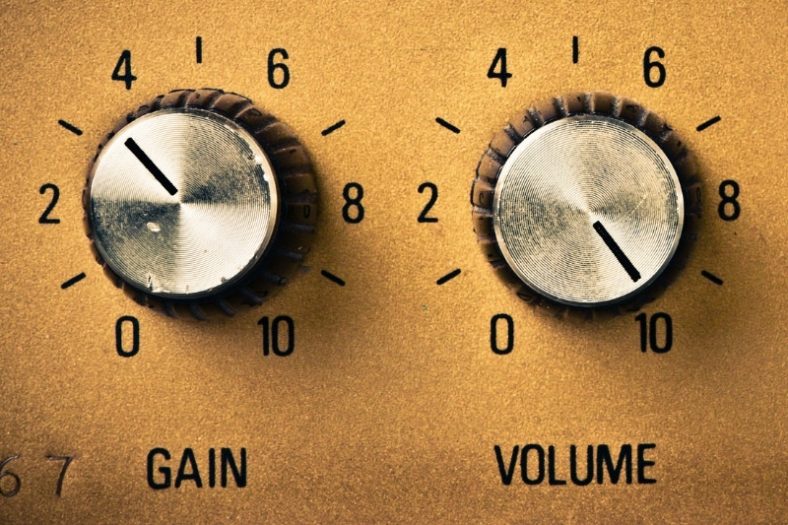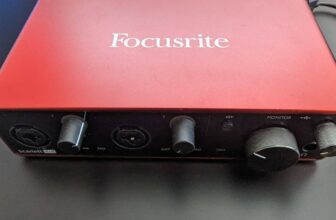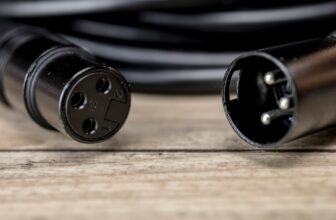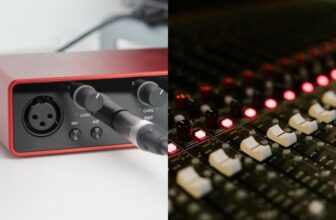Gain vs Volume (What is the Difference)

The volume is used to control the loudness of the output of a speaker, while the gain is used to control the loudness of the input inside an audio system.
Gain and volume are similar concepts but they are different. People tend to mix up these two quite often, but it’s critical to know the difference between the two when working with audio.
Volume is the measure of the output of an audio system (in dB), whereas gain is the ratio of the amplitude of the output of an audio system divided by the input amplitude.
Contents
How are volume and gain different?
Volume and gain are similar and often confused because they both modulate the amplitude of a signal, hence changing its perceived loudness. However, they’re different because the volume is a non-invasive measurement of sound that doesn’t affect audio quality, while the gain is a reference for signal strength that affects the quality of audio.
In music production, the most important notion to keep track of is that, unlike volume, gain application changes an audio system in itself, causing its characteristics to change. Applying volume to an audio track only changes its loudness, while applying gain to an audio track changes its sound. When abused, the gain can give way to clipping and distortion, which can have a severe negative impact on the overall quality of a mix.
What is volume?
To put it simply, the volume represents how loud or quiet a sound is. Using volume in music production is a very straightforward process because volume application will not affect the quality of a sound.
To understand volume, you just need to think of it as a gateway. When the volume is closed (i.e., a volume fader is placed all the way down), an audio system will be mute. When the volume is open (i.e., a volume fader is placed all the way up), an audio system will play at maximum loudness. To raise a volume fader is simply to allow a given amount of loudness in an audio system to be reproduced.
Volume has a pivotal role in mixing because it controls the loudness of each track, hence altering the balance of the overall mix. However, its application doesn’t interfere with the color, timber, and quality of each of the audio tracks in itself.
What is gain?
Gain is a reference for signal strength that allows for the control of loudness and tone within an audio system. To the untrained ear, applying gain to a track may sound a lot like applying volume to a track—the sound gets louder, and that’s about it. However, every audio engineer will tell you that gain can make or break a mix.
Why? Because every time you increase the gain of an audio system, you will also change its tone. This means that the characteristics of the audio itself will change, causing a track to sound noticeably different.
What is gain used for in music production?
Gain is indispensable for music production because it’s used for amplifying quiet sounds while reducing its noise floor. When an engineer records a vocal track (for instance), the audio signal will be very quiet. To fit in the mix, such a signal needs to be amplified. That’s why most mic-inputs need to either include or pass through a preamp, a device that raises the loudness of the recording to the desired level.
This is when gain comes in – the gain has the unique ability to increase the loudness of an audio track without boosting its noise floor. It may sound complicated, but it’s extremely simple once you try a little experiment in your DAW.
Try to record a relatively quiet vocal track. Then, use the volume fader to raise its loudness. You will immediately notice that the noise in the recorded track will be very perceivable, jeopardizing its sound quality. But once you apply gain instead of volume to the track, the recording will sound as loud while containing minimal to no noise.
In a nutshell, there are two ways of misusing gain in music production: you can either have too little of it or too much of it.
Too little gain will harm recorded tracks because it will cause their noise levels to be much more perceivable. Too much gain will give way to sound artifacts such as clipping and distortion, causing a track’s tone to change.
Experienced audio engineers know how to make the best of clipping and distortion, which can be tamed with the help of audio effects such as compressors and limiters. However, a clean mix is often distortion-free and well-balanced in terms of gain.
Generally speaking, the gain is used to modulate the balance of a mix in the input, which means it’s mostly applied after recording. Volume, on the other hand, is more frequently used at the end of the process, to delicately balance the different audio tracks that coexist within a mix.
What is gain staging?
In music production, gain staging is the process of making sure that every track in a mix is at its optimal loudness level, without containing too much noise or distortion. Gain staging is not so much about balancing the different tracks in a mix, but about making sure that every audio system has the desired loudness and sound quality.
If the gain level varies considerably between tracks, you won’t know whether it’s an improvement to the sound or just an increased volume.
When gain-staging, it’s important to keep in mind that gain is additive. This means that the overall loudness of a mix will not be defined by its loudest point. If a mix contains two audio tracks peaking at -6dB, the peak level of the mix will not be -6dB, but rather -3dB. For this reason, gain staging is pretty much about maintaining headroom in a mix without sacrificing its musicality (i.e., the perceived quality of each of its individual tracks).
What is headroom in music?
In mixing, headroom is the space between the highest peak in the song and the superlative peak level of 0dB. The 0dB peak level is important in music production because it is the maximum possible value of loudness digital audio can have without clipping. However, please keep in mind maximum peak levels may vary according to the type of speakers and music equipment you’re using.
When mixing, audio engineers recommend maintaining a headroom of about-8dB and -6dB. This means that your overall mix should ideally peak at one of these values. But why?
This is common practice in mixing because virtually all modern-day mixes will need to be mastered before release. The -8dB to -6dB “sweet spot” is there for the mastering engineer to have enough room to apply effects such as compressors, limiters, and imagers to the master channel without compromising the overall sound quality of a song.
Summary
It’s important to know the difference between gain and volume, as they tend to be mixed up by people quite often.
Another thing to keep in mind is gain staging. It’s an important process in music production that helps to maintain a clean mix without distortion or noise. It’s important to keep in mind the additive nature of gain when adjusting levels, and to make sure that every track in a mix is at its optimal loudness.
Maintaining headroom is also essential when mixing, because it gives the mastering engineer enough room to apply effects without compromising a song’s overall quality.





